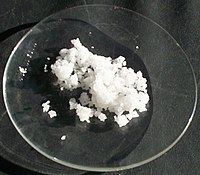
Photo from wikipedia
Abstract Engineered metal-oxide nanoparticles have greatly been used in various bio-applications, but their physicochemical properties change dramatically within a bio-system. Therefore, the development of new metal-oxide nanoparticles and proper understanding… Click to show full abstract
Abstract Engineered metal-oxide nanoparticles have greatly been used in various bio-applications, but their physicochemical properties change dramatically within a bio-system. Therefore, the development of new metal-oxide nanoparticles and proper understanding of their toxicity profile in bio-environment are very important for advancement of cancer-related diagnostic and therapeutic approaches. Nanostructured wide-bandgap semiconductors ZnSn(OH)6 and Zn2SnO4 are fabricated by one-pot hydrothermal synthesis and tested for the first time in anti-cancer treatments. The crystalline zinc-hydroxystannate is converted by high-temperature annealing into amorphous and then crystalline zinc-orthostannate, as confirmed by Rietveld refinement analyses. A dose-dependent cytotoxicity is observed when human cervical carcinoma cell lines are exposed to these nanomaterials, mainly due to the elevation of intracellular reactive-oxygen-species levels in the treated cells, which leads to oxidative stress and cell damage. The crystalline phases of the nanomaterials reveal better cell-killing efficacy due to the overlap of the conduction-band energy levels with the cellular redox potential, leading to favorable electron transfer from the biological redox couples to the conduction-band of the semiconductor nanoparticles, thus producing more reactive-oxygen-species for cell damage. Importantly, this higher reactive-oxygen-species production by the crystalline samples significantly reduces cancer cell migration and proliferation and decreases metastasis, which remains an unmet challenge in cancer therapy.
Journal Title: Materials Chemistry and Physics
Year Published: 2020
Link to full text (if available)
Share on Social Media: Sign Up to like & get
recommendations!